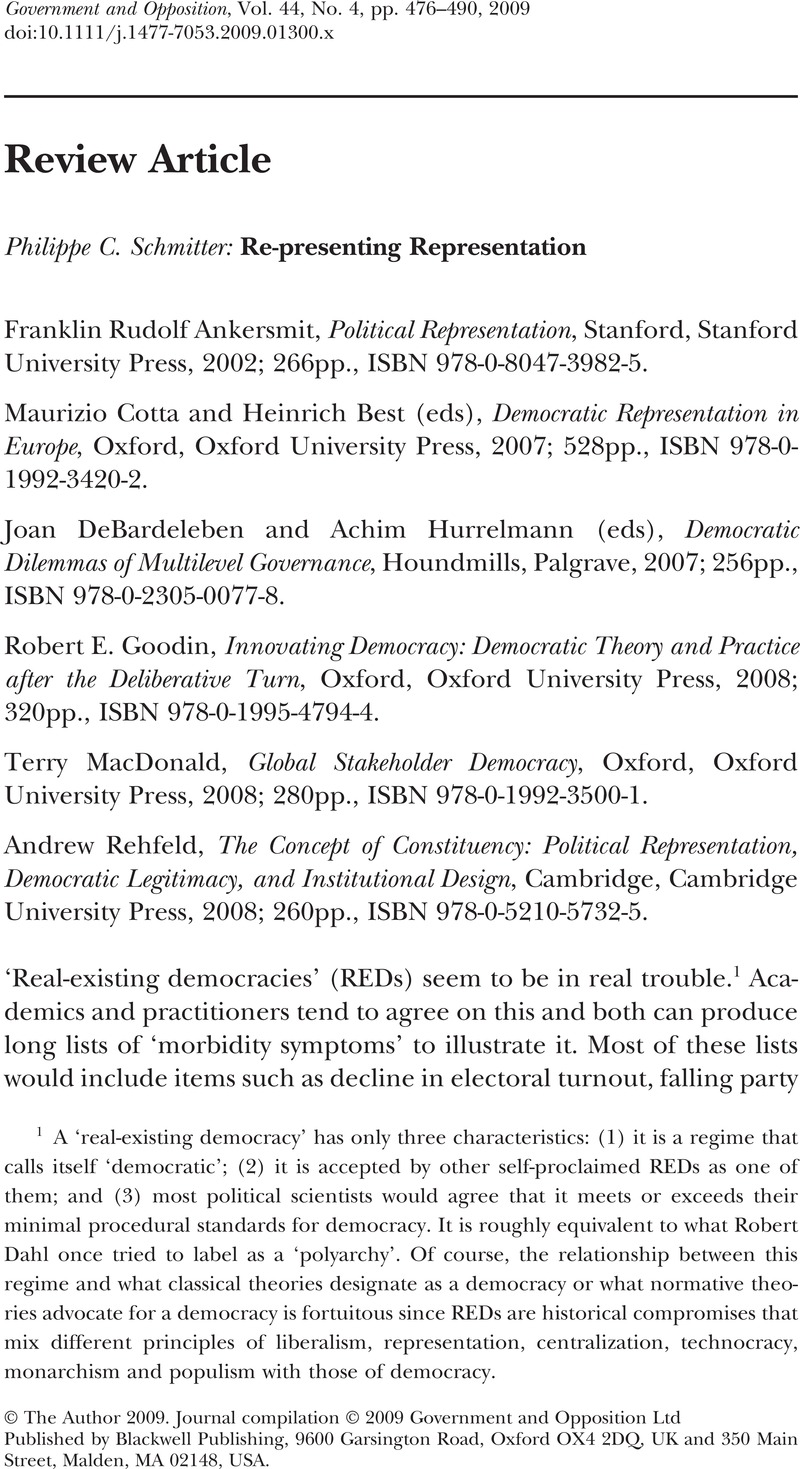Article contents
Re-presenting Representation
Published online by Cambridge University Press: 02 January 2013
Abstract

- Type
- Review Article
- Information
- Copyright
- Copyright © The Author(s) 2009.
References
1 A ‘real-existing democracy’ has only three characteristics: (1) it is a regime that calls itself ‘democratic’; (2) it is accepted by other self-proclaimed REDs as one of them; and (3) most political scientists would agree that it meets or exceeds their minimal procedural standards for democracy. It is roughly equivalent to what Robert Dahl once tried to label as a ‘polyarchy’. Of course, the relationship between this regime and what classical theories designate as a democracy or what normative theories advocate for a democracy is fortuitous since REDs are historical compromises that mix different principles of liberalism, representation, centralization, technocracy, monarchism and populism with those of democracy.Google Scholar
2 ‘The political parties created democracy and modern democracy is unthinkable save in terms of the parties’, E. E. Schattschneider, Party Government, New York, Rhinehart & Co., 1942, p. 1. Leaving aside the fact that the first part of this statement is manifestly not true, the second remains ‘foundational’ for much of contemporary political science.Google Scholar
3 Maurizio Cotta and Heinrich Best (eds), Parliamentary Representatives in Europe, 1848–2000. Legislative Recruitment and Careers in Eleven European Countries, Oxford, Oxford University Press, 2000.Google Scholar
4 Cotta and Best, Democratic Representation, p. 474.Google Scholar
5 Ibid., p. 4.Google Scholar
6 Ibid., pp. 476–8.Google Scholar
7 Ibid., p. 479.Google Scholar
8 Ankersmit, Political Representation, p. 97.Google Scholar
9 Obviously, the timing of the English and American Revolutions – not to mention their less contentious aftermaths – places representative democracy in these two countries on a different historical trajectory. Ankersmit observes this divergence between Anglo-Saxon and Continental representative democracies and attributes the predominance of two-party systems in the former and multiparty systems in the latter to this factor (pp. 99–104).Google Scholar
10 Ankersmit, Political Representation, p. 98.Google Scholar
11 Ibid., p. 128.Google Scholar
12 Ibid., p. 129.Google Scholar
13 Ibid., p. 132.Google Scholar
14 MacDonald, Global Stakeholder Democracy, p. 13.Google Scholar
15 The fact that much of the funding for NGOs comes from donations by foundations and subsidies by governments is presumably of minor importance.Google Scholar
16 MacDonald, Global Stakeholder Democracy, p. 87.Google Scholar
17 Goodin, Innovating Democracy, p. 15.Google Scholar
18 Ibid., p. 211.Google Scholar
19 Rehfeld does not ask why the citizenry as a whole deserve their inclusion within a particular state. This has long been conundrum of democratic theory since it provides no convincing ex ante mechanism or ex post justification for determining the boundaries of that unit. In his Innovating Democracy, Goodin tackles this issue by reviving the ancient Roman formula quod omnes tangit, ab omnibus approbari debet – that which affects everyone must be approved by everyone. Unfortunately, his ‘solution’ is manifestly implausible in its reference to ‘interests’ since they cannot be either subjectively experienced nor objectively assessed independently from the sociopolitical unit that ‘constructs’ them.Google Scholar
20 Something roughly similar happens in those polities where the entire country is a single electoral district (or a limited number of very large ones), but winners are determined from list systems by proportional representation. The experience in countries such as Israel, Moldova, Latvia, Estonia and Brazil does not suggest that the party representatives elected in this fashion are any more legitimate – rather the contrary.Google Scholar
21 Rehfeld, The Concept of the Constituency, pp. 222–6.Google Scholar
- 9
- Cited by




